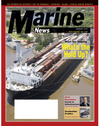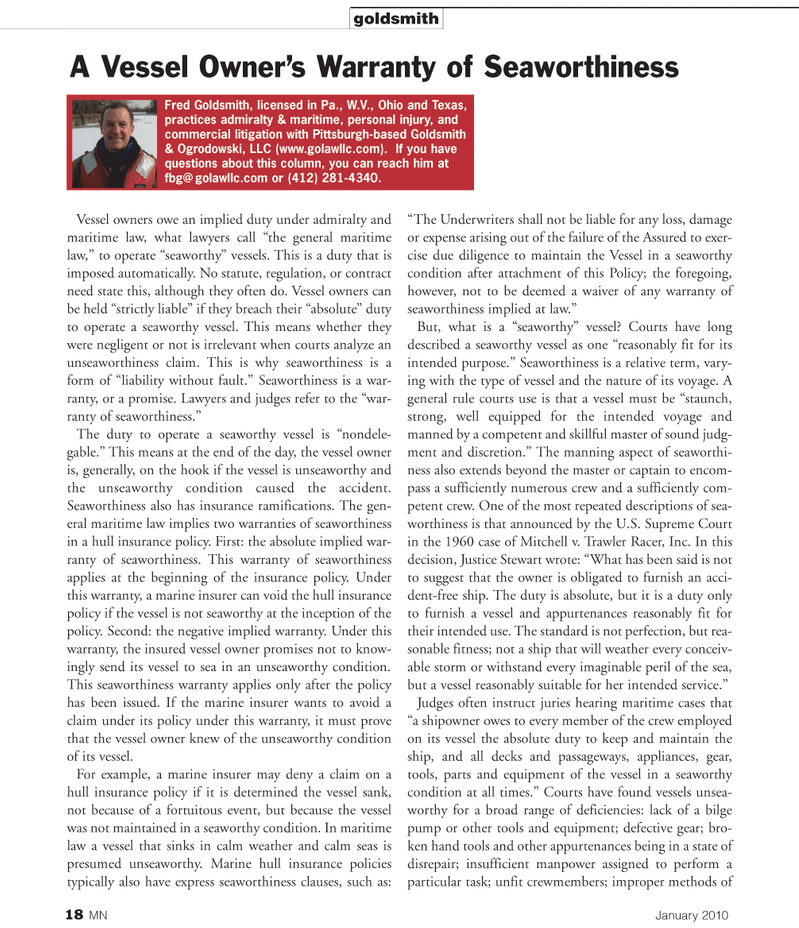
Page 18: of Marine News Magazine (January 2, 2010)
Read this page in Pdf, Flash or Html5 edition of January 2, 2010 Marine News Magazine
Vessel owners owe an implied duty under admiralty and maritime law, what lawyers call “the general maritime law,” to operate “seaworthy” vessels. This is a duty that is imposed automatically. No statute, regulation, or contract need state this, although they often do. Vessel owners can be held “strictly liable” if they breach their “absolute” duty to operate a seaworthy vessel. This means whether they were negligent or not is irrelevant when courts analyze an unseaworthiness claim. This is why seaworthiness is a form of “liability without fault.” Seaworthiness is a war- ranty, or a promise. Lawyers and judges refer to the “war- ranty of seaworthiness.”
The duty to operate a seaworthy vessel is “nondele- gable.” This means at the end of the day, the vessel owner is, generally, on the hook if the vessel is unseaworthy and the unseaworthy condition caused the accident.
Seaworthiness also has insurance ramifications. The gen- eral maritime law implies two warranties of seaworthiness in a hull insurance policy. First: the absolute implied war- ranty of seaworthiness. This warranty of seaworthiness applies at the beginning of the insurance policy. Under this warranty, a marine insurer can void the hull insurance policy if the vessel is not seaworthy at the inception of the policy. Second: the negative implied warranty. Under this warranty, the insured vessel owner promises not to know- ingly send its vessel to sea in an unseaworthy condition.
This seaworthiness warranty applies only after the policy has been issued. If the marine insurer wants to avoid a claim under its policy under this warranty, it must prove that the vessel owner knew of the unseaworthy condition of its vessel.
For example, a marine insurer may deny a claim on a hull insurance policy if it is determined the vessel sank, not because of a fortuitous event, but because the vessel was not maintained in a seaworthy condition. In maritime law a vessel that sinks in calm weather and calm seas is presumed unseaworthy. Marine hull insurance policies typically also have express seaworthiness clauses, such as: “The Underwriters shall not be liable for any loss, damage or expense arising out of the failure of the Assured to exer- cise due diligence to maintain the Vessel in a seaworthy condition after attachment of this Policy; the foregoing, however, not to be deemed a waiver of any warranty of seaworthiness implied at law.”
But, what is a “seaworthy” vessel? Courts have long described a seaworthy vessel as one “reasonably fit for its intended purpose.” Seaworthiness is a relative term, vary- ing with the type of vessel and the nature of its voyage. A general rule courts use is that a vessel must be “staunch, strong, well equipped for the intended voyage and manned by a competent and skillful master of sound judg- ment and discretion.” The manning aspect of seaworthi- ness also extends beyond the master or captain to encom- pass a sufficiently numerous crew and a sufficiently com- petent crew. One of the most repeated descriptions of sea- worthiness is that announced by the U.S. Supreme Court in the 1960 case of Mitchell v. Trawler Racer, Inc. In this decision, Justice Stewart wrote: “What has been said is not to suggest that the owner is obligated to furnish an acci- dent-free ship. The duty is absolute, but it is a duty only to furnish a vessel and appurtenances reasonably fit for their intended use. The standard is not perfection, but rea- sonable fitness; not a ship that will weather every conceiv- able storm or withstand every imaginable peril of the sea, but a vessel reasonably suitable for her intended service.”
Judges often instruct juries hearing maritime cases that “a shipowner owes to every member of the crew employed on its vessel the absolute duty to keep and maintain the ship, and all decks and passageways, appliances, gear, tools, parts and equipment of the vessel in a seaworthy condition at all times.” Courts have found vessels unsea- worthy for a broad range of deficiencies: lack of a bilge pump or other tools and equipment; defective gear; bro- ken hand tools and other appurtenances being in a state of disrepair; insufficient manpower assigned to perform a particular task; unfit crewmembers; improper methods of goldsmith
A Vessel Owner’s Warranty of Seaworthiness
Fred Goldsmith, licensed in Pa., W.V., Ohio and Texas, practices admiralty & maritime, personal injury, and commercial litigation with Pittsburgh-based Goldsmith & Ogrodowski, LLC (www.golawllc.com). If you have questions about this column, you can reach him at fbg@ golawllc.com or (412) 281-4340. 18 MN January 2010

 17
17

 19
19
